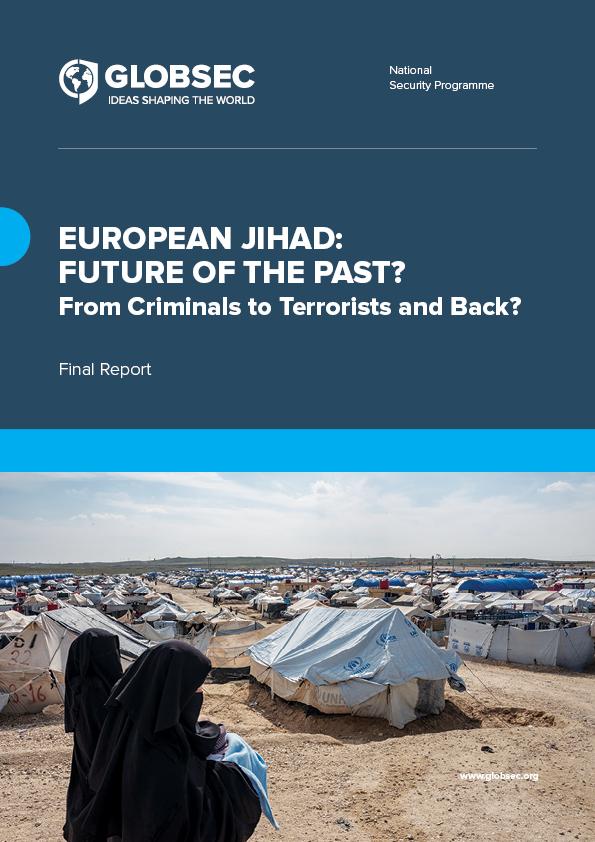European Jihad: Future of the Past? From Criminals to Terrorists and Back? Final Report

This is the final report of the GLOBSEC’s From Criminals to Terrorists and Back?, a two year advocacy and research project funded under PMI Impact, a global grant initiative of Philip Morris International to support projects against illegal trade (GLOBSEC is fully independent in implementing the project and has editorial responsibility for all views and opinions expressed herein).
It picks up from where the previous report, titled “Who Are The European Jihadis?,” published in September 2018, left off See Publication HERE. The report’s launch was covered by the media in 20+ countries, including quotes in The New York Times, BuzzFeed, Le Parisien, Bild, HLN, de Volskrant, Gazeta Wyborcza, SME, 444.hu, Sky News Arabia, and others. That report’s findings were based on a unique dataset of 197 European jihadis from 2015, the peak year of European jihadis. Thanks to the work of the research teams based in 11 countries (including the personnel from IRIS, France; University College Cork; Leiden University; Ghent University; Catholic University of the Sacred Heart, Italy; University Rey Juan Carlos and Elcano Royal Institute, Spain; and Center for the Study of Democracy, Bulgaria), GLOBSEC was able to study 120+ variables related to each and every individual included in the dataset and was consequently able to provide a 360 degree outlook on who European jihadis truly are, where they come from, how they had been radicalised and where, how networked they are within the broader jihadi milieu in Europe, etc.
This report takes the work further as it is based on an updated unique dataset of 326 European jihadis (from 2015, the peak year of European jihadism) who have all either been arrested for terrorism offences (with 199 later convicted), expelled from a given country because of their alleged terrorism links (39 individuals), died while executing terrorist attacks abroad or in one of the 11 EU countries (50; Austria, Belgium, Bulgaria, France, Germany, Greece, Ireland, Italy, the Netherlands, Spain, and the UK, i.e., those that reported more than 20 terrorism arrests reported to Europol that year), or are still at large and are sought by security authorities (38).
The individual stories of the European jihadis often point out to the long-term nature of their jihadi involvement and the fact that many of them will be released from prison in the upcoming years. In this sense, the report points to the “future of the past” of European jihadism.
The report consists of two parts: the first offers GLOBSEC’s National Security Programme take on three burning issues we estimate are of key importance to the current European counterterrorism effort, namely: a) the seemingly ever-present phenomenon of (returning) foreign terrorist fighters (FTFs); b) (terrorism) recidivism; and c) the role of women in European jihadism. The second offers an update on data GLOBSEC published in September 2018, and updated GLOBSEC’s take on the issue of who European jihadis are.
Re 1a) FTFs subset constitute 33% of the overall dataset (107 out of 326). They are more likely than the other European jihadis to have had a previous career in crime and enjoy longer jihadi careers which relatively often result in their being jailed for terrorism offences on more than one occasion. They are extremely well networked within the jihadi milieu, as they often know individuals from previous generations who also partook in other “jihads.” Upon returning from the battle zones, they often play the role of jihadi entrepreneurs or charismatic cell or network leaders, or individuals to whom their comrades look up to. In effect, they are European jihad’s force multipliers, both practically and via their inspiring life stories, including hardships while imprisoned in e.g. Iraq or Syria, which will continue to animate future generations of jihadis. GLOBSEC anticipates that the swifter their repatriation or conclusion of court proceedings are in their cases, the lesser is their “narrative” value for the jihadi milieu in Europe.
Re 1b) European jihad is no stranger to perennial criminals and involves a significant number of individuals who have had long-term terrorist careers and perpetrated numerous terrorist crimes throughout it. They are also likely to continue doing so after their releases. Out of the 199 individuals arrested for terrorism offences in 2015 included in GLOBSEC dataset, 57%, will be released from prison by the end of 2023. As many as 45 have already been released from prison, as they had received relatively short sentences. GLOBSEC anticipates that the release of these individuals from confinement, a seemingly past issue constitutes and will constitute a challenge for the security authorities in the future.
Re 1c) Female jihadis are not simply “jihadi brides.” GLOBSEC dataset includes cases of attack planners, active female jihadi recruiters, propagandists, etc. Moreover, the women in the subset are also very well networked into the jihadi milieu, and many wish to, albeit few successfully complete the process, travel to a conflict zone. This strongly disproves the theory of a lack of female agency within the larger jihadi milieu. GLOBSEC anticipates that in the future they might play even more significant roles in further development of European jihad, and the European CT strategies should; therefore, go beyond the “bride” paradigm and prepare for more terrorist challenges animated by or orchestrated by females.
Re 2) The phenomenon of European jihad is mostly male, involves young but not teenage or adolescent individuals; homegrown in nature, but to some extent involves naturalised individuals and immigrants; infested with former, but not necessarily “petty,” criminals; financed by a variety of means, but surprisingly legal in this sphere; concerned with travelling to and returning from foreign conflicts; slow to mature as the radicalisation fuelling often takes years; is a family affair and team effort; is performed by unemployed and uneducated individuals.
Europe clearly “has not won its war on terrorism”—a detailed study of individuals involved in European jihad in 2015 demonstrates that the threat will be making its presence felt in Europe for years to come and the longevity of the threat is demonstrated by three of the issues discussed in this report: the role of foreign fighters as force multipliers; the issue of recidivism amongst terrorism prisoners and their pending releases; the potential for the growth of the standing of women within terrorism networks.
Simultaneously, the crime-terror nexus in Europe truly is a “poor man’s crime-terror nexus” as its representatives are former, and relatively unsuccessful, criminals whose jobs do not amount to bringing in a sizeable skillset to their new terrorist patrons. If, however, a given criminal career takes place in an area with a history of jihadi activities, and the individual’s family and friends are known to the security authorities for their radical activities, involvement and sympathies, then adequate resources should be utilised to ascertain the extent to which the individual could be progressing along a private crime-terror continuum. While establishing if that is the case; however, the authorities should refrain from generalisations and ensure a wider understanding of the phenomenon at hand is developed. This necessitates investment in long-term projects devoted to what we could call the phenomenon of “football buddies.” By such “buddies” GLOBSEC means, e.g., individuals who have known the radicals in their area, spent time with them, in some cases were also radicalised but never opted for terrorism involvement. Such projects would therefore also look at criminals and former criminals who could, but never did, move farther along the crime-terror nexus axis. Clues as to what radicalisation entails and how it truly operates could lie within the answers provided by such endeavours.
